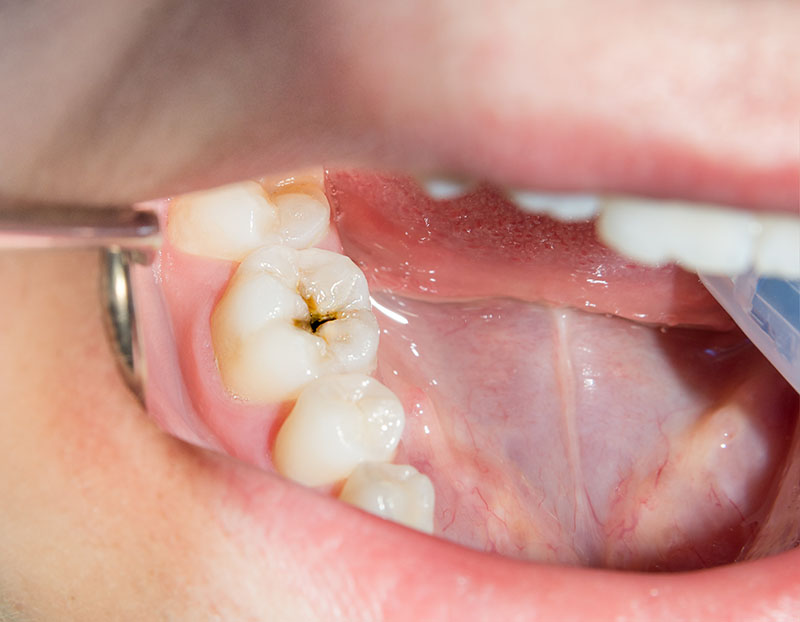Cavities and Dental Decay
Dental cavities, or caries, are caused by tooth decay and affect patients of all ages. They typically result from oral bacteria, sugary diets, and poor hygiene. A strong treatment plan and good oral habits are key to preventing cavities and maintaining long-term dental health.
Our dental practice is dedicated to helping patients build effective routines, understand the causes of decay, and reduce future risks. By promoting early detection and proactive care, we aim to support lasting oral wellness and healthy smiles.


Causes of Cavities and Dental Decay
Cavities are the result of a combination of factors primarily influenced by oral hygiene, dietary habits, and bacterial activity within the mouth. Understanding these contributing causes is fundamental in preventing cavity formation and maintaining good oral health.
Diet is the next most common cause in cavity development. Frequent consumption of sugary or acidic foods and beverages heightens the risk. Sugary treats, sodas, candies, and even natural sugars found in fruits can feed the bacteria in our mouth, promoting acid production and enamel erosion. Acidic foods and drinks can directly weaken enamel, making teeth more susceptible to decay.
One of the causes of cavities is bacteria. The human mouth hosts numerous types of bacteria, some of which form a sticky biofilm called plaque, which forms on tooth surfaces. These bacteria thrive on sugars and carbohydrates from food remnants left in the mouth after eating. As bacteria feed on these sugars, they produce acids that can erode the protective enamel layer of teeth, leading to cavity formation.
Inadequate oral hygiene practices significantly contribute to cavities. Poor flossing and brushing habits allow plaque to accumulate on your teeth, providing a breeding ground for harmful bacteria. When plaque is not regularly removed, it hardens into tartar, increasing the risk of decay and gum disease.
Conditions that lead to reduced saliva production, such as certain medications, medical treatments, or health issues, can contribute to cavity formation. Saliva plays a crucial role in neutralizing acids in the mouth and aiding in the remineralization of enamel. Reduced saliva flow diminishes the mouth's natural defense mechanism against cavities.
Types and Symptoms of Dental Cavities
Cavities and dental decay can cause a range of symptoms, including toothaches, sensitivity, discoloration, visible holes, pain while chewing, bad breath, or pus around the tooth. Recognizing these signs early and seeking dental care helps prevent further damage and discomfort.
Cavities can form above or below the gum line and vary in severity—from early enamel damage to deeper decay. Regular dental check-ups are essential for early detection, and maintaining good oral hygiene and a healthy diet plays a key role in prevention.
These cavities occur on the flat surfaces of our teeth and are typically the result of plaque buildup. They often progress slowly and can be easier to detect during regular dental check-ups.
Found on the chewing surfaces of molars and premolars, these cavities occur in the pits and fissures of teeth, making them more susceptible to food particle accumulation and decay. These areas can be more challenging to clean effectively, leading to increased cavity risk.
Root cavities develop on the tooth roots, usually in patients with gum recession or periodontal disease. When gums recede, the tooth roots become exposed, making them vulnerable to decay. Root cavities can progress rapidly due to the softer nature of root surfaces compared to enamel.
These are the most common type and occur on the crown or visible surface of a tooth. Coronal cavities can affect both enamel and dentin, progressing deeper into the tooth structure if left untreated.
Sometimes referred to as secondary cavities, these develop around existing dental fillings, crowns, or other restorative dental work. They occur due to the breakdown of the material or the presence of bacteria at the margins of the dental restoration.
This type of cavity specifically affects infants and toddlers. It is often associated with prolonged exposure to sugary liquids such as milk, formula, or fruit juice in baby bottles, especially when the child is put to bed with a bottle. Baby bottle tooth decay commonly affects the upper front teeth.
Treatments and Prevention Tips
Treatments for cavities and tooth decay aim to remove the decayed portion of a tooth and restore its structure. Prevention strategies focus on reducing the risk factors associated with cavity development. Depending on the severity of the cavity, our dentist will assess your tooth to determine the most appropriate method for restoring its function.
Fillings
Our dentist typically uses fillings to treat cavities. The decayed portion of the tooth is removed, and the resulting space is filled with a material such as composite resin, or porcelain to restore the tooth's shape and function.
Crowns
For more extensive decay that weakens the tooth's structure, a crown might be necessary. This involves reshaping the tooth and placing a crown over it to protect and restore its functionality.
Root Canal Treatment
When decay reaches the tooth's pulp, causing infection or severe pain, a root canal may be necessary. This procedure involves removing the infected pulp, cleaning the area, and sealing it to save the tooth.
Tooth Extraction
In cases where the tooth is extensively decayed and cannot be restored, extraction might be the only option to prevent the spread of infection to the surrounding teeth.
Preventing cavities and tooth decay requires good oral hygiene, healthy habits, and regular dental care. Key steps include brushing twice daily, flossing after meals, using fluoride, eating a balanced diet, staying hydrated, chewing sugar-free gum, avoiding tobacco, considering dental sealants, and visiting the dentist every 4–6 months. These practices greatly reduce the risk of decay and support long-term oral health.





